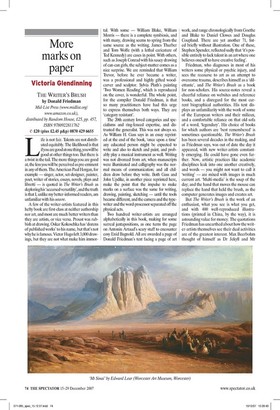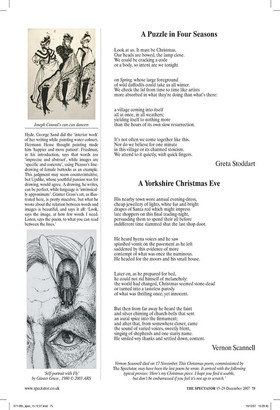More marks on paper
Victoria Glendinning THE WRITER'S BRUSH by Donald Friedman Mid-List Press (www.midlist.mg1 www.amazon.co.uk), distributed by Random House, £25, pp. 457, ISBN 9780922811762 £20 (plus £2.45 p&p) 0870 429 6655 Life is not fair. Talents are not distributed equitably. The likelihood is that ifyou are good at one thing, youwill be good at other things too. But there is a twist in the tail. The more things you are good at, the less you will be perceived as pre-eminent in any of them. The American Paul Horgan, for example — singer, actor, set-designer, painter, poet, writer of stories, essays, novels, plays and libretti — is quoted in The Writer's Brush as deploring his 'accursed versatility', and the truth is that I, unlike my better-informed readers, am unfamiliar with his oeuvre.
A few of the writer-artists featured in this hefty book are first-class at neither authorship nor art, and most are much better writers than they are artists, or vice versa. Proust was rubbish at drawing. Oskar Kokoschka has 'dozens of published works' to his name, but that's not why he is famous. Victor Hugo left 3,000 drawings, but they are not what make him immortal. With some — William Blake, William Morris — there is a complete symbiosis, and with many, drawing seems to spring from the same source as the writing. James Thurber and Tom Wolfe (with a lethal caricature of Ted Kennedy) are cases in point. With others, such as Joseph Conrad with his saucy drawing of can-can girls, the subject-matter comes as a nice surprise. We are reminded that William Trevor, before he ever became a writer, was a professional and highly gifted woodcarver and sculptor. Sylvia Plath's painting 'Two Women Reading', which is reproduced on the cover, is wonderful. The whole point, for the compiler Donald Friedman, is that so many practitioners have had this urge to express themselves both ways. They are 'category resistant'.
The 20th century loved categories and specialisms and ring-fenced expertise, and distrusted the generalist This was not always so. As William H. Gass says in an essay reprinted at the end of the book, 'once upon a time' any educated person might be expected to write and also to sketch and paint, and probably play a musical instrument as well. Writing was not divorced from art, when manuscripts were illuminated and calligraphy was the normal means of communication; and all children draw before they write. Both Gass and John Updike, in another piece reprinted here, make the point that the impulse to make marks on a surface was the same for writing, drawing, painting, sketching — until the tools became different, and the camera and the typewriter and the word-processor separated off the physical acts.
Two hundred writer-artists are arranged alphabetically in this book, making for some surreal juxtapositions, as one turns the page on Antonin Artaud's scary stuff to encounter cosy Enid Bagnold. All are awarded a page of Donald Friedman's text facing a page of art work, and range chronologically from Goethe and Blake to Daniel Clowes and Douglas Coupland. There are yet another 71, listed briefly without illustration. One of these, Stephen Spender, reflected sadly that 'it's possible entirely to lack talent in an art where one believes oneself to have creative feeling'.
Friedman, who diagnoses in most of his writers some physical or psychic injury, and sees the recourse to art as an attempt to overcome trauma, describes himself as a 'dilettante', and The Writer's Brush as a book for non-scholars. His source-notes reveal a cheerful reliance on websites and reference books, and a disregard for the most current biographical authorities. His text displays an unfamiliarity with the work of some of the European writers and their milieux, and a comfortable reliance on that old sofa of a word, 'legendary'. His choice of books for which authors are 'best remembered' is sometimes questionable. The Writer's Brush has been several decades in the making, and as Friedman says, was out of date the day it appeared, with new writer-artists constantly emerging. He could have gone even further. Now, artistic practices like academic disciplines leak into one another creatively, and words — you might not want to call it 'writing' — are mixed with images in much current art. 'Multi-media' is the soup of the day; and the hand that moves the mouse can replace the hand that held the brush, as the computer generates images and creates art.
But The Writer's Brush is the work of an enthusiast, what you see is what you get, and with 400 well-reproduced illustrations (printed in China, by the way), it is astounding value for money. The quotations Friedman has unearthed about how the writer-artists themselves see their dual activities are of the greatest interest. Max Beerbohm thought of himself as Dr Jekyll and Mr Hyde. George Sand did the 'interior work' of her writing while painting water-colours. Hermann Hesse thought painting made him 'happier and more patient'. Friedman, in his introduction, says that words are 'imprecise and abstract', while images are 'specific and concrete', using Picasso's linedrawing of female buttocks as an example. This judgment may seem counterintuitive, but Updike, whose youthful passion was for drawing, would agree. A drawing, he writes, can be perfect, while language is 'intrinsically approximate'. Gunter Grass's art, as illustrated here, is pretty macabre, but what he wrote about the relation between words and images is beautiful, and says it all: 'Look, says the image, at how few words I need. Listen, says the poem, to what you can read between the lines.'


































































































 Previous page
Previous page